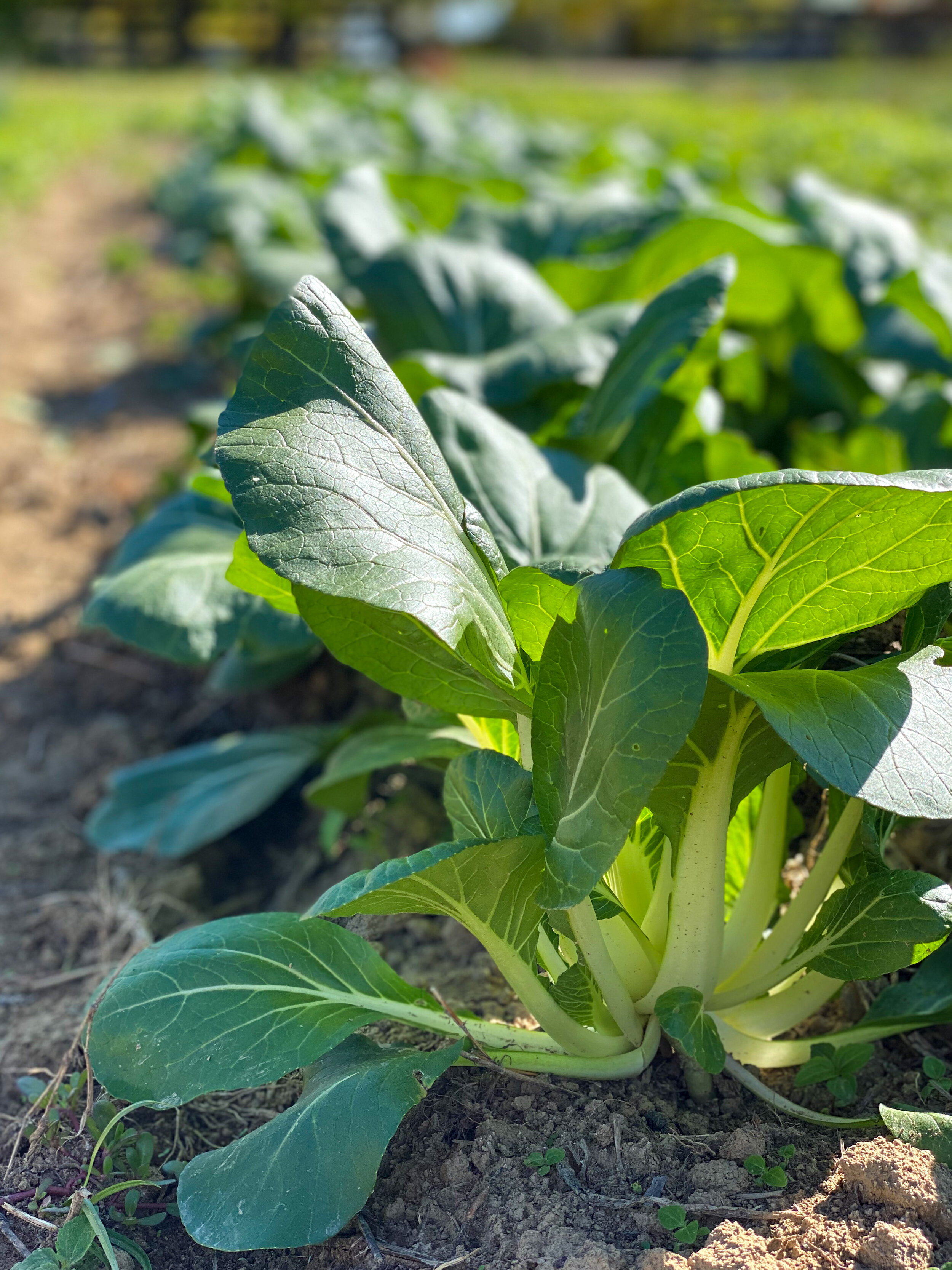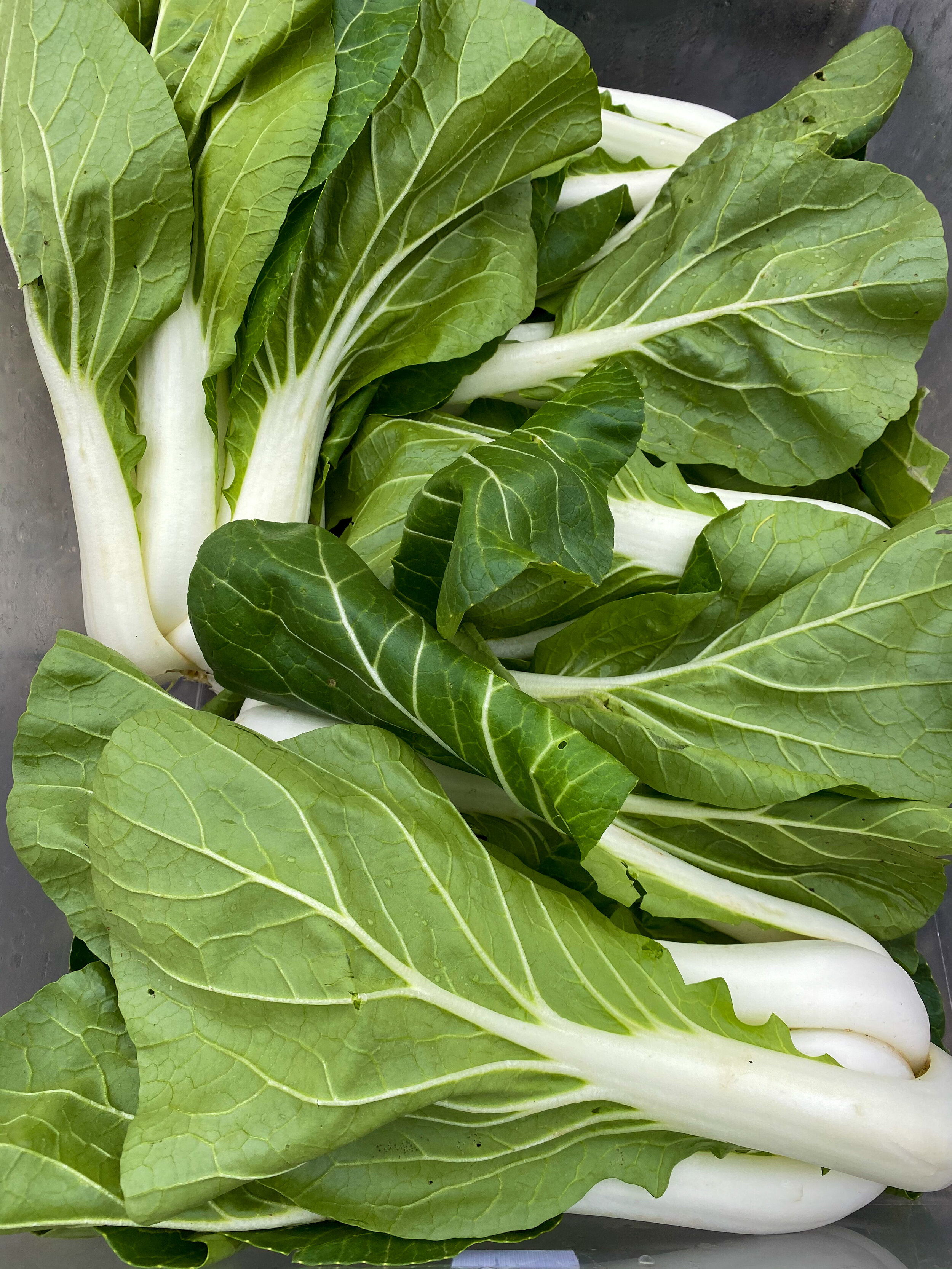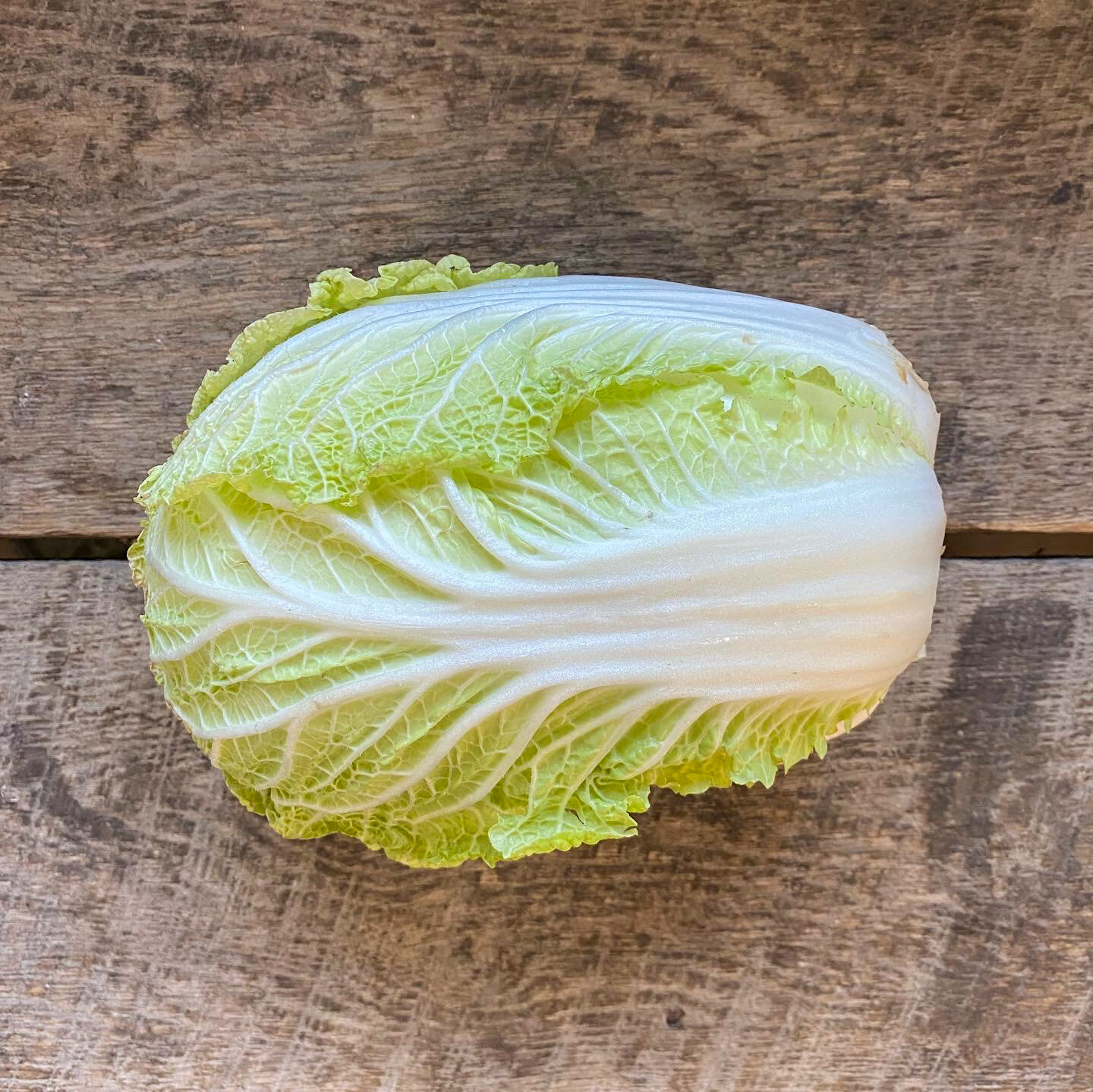Announcements
In Season Now: Chinese Cabbage
In season now and as crisp as the fall weather itself: Chinese cabbage. Learn more about two varieties we grow at Turner Farm, bok choy and napa cabbage, plus get recipe ideas.
In season now and as crisp as the fall weather itself: Chinese cabbage. At Turner Farm, we grow a few varieties of organic Chinese cabbage, which refers to not one but two cultivars of Chinese leaf vegetables in the mustard family: pac choi (the Chinensis group, more commonly known as bok choy in our part of the world, including in our Farm Market) and napa cabbage (the Pekinensis group):
Bok Choy
Bok choy is less like a cabbage in that it doesn’t form a head. Instead it has a bulbous base that sprouts a cluster of leafy green blades that are mild and sweet, with crunchy, juicy stems. It “delivers a potent vitamin cocktail, including a big dose of rare cancer-fighting nitrogen compounds called indoles, as well as folic acid, iron, beta-carotene, and potassium,” according to editors at Men’s Health. At Turner Farm, we grow full-size heads of varieties like win-win choi, as well as baby bok choy such as mei qing choi. Bok choy shrinks less than your usual cabbage when cooked, and doesn’t need much preparation to become a delicious dish:
Stir fry bok choy with garlic for a quick, winning side.
Roast it whole in this keto-friendly garlic roasted bok choy recipe.
Add it to a warming batch of ginger noodle soup or bok choy chicken soup.
Pair it with pasture-raised chicken in an easy meal of chicken stir fry with bok choy.
Add it raw to a refreshing apple bok choy salad.
Napa Cabbage
The thick white ribs and crinkly yellow-green leaves of napa cabbage are tender crisp, and have a sweet flavor that’s more mellow than that of its pungent European cabbage cousins. Napa cabbage can be eaten raw or cooked. It’s also a great source of vitamin A and C, and contains only 7.4 calories per ounce (nutrition data).
Use the raw leaves in place of iceberg lettuce in a wedge salad.
Stir fry it with a piquant sauce to make hot and sour cabbage, a Northern Chinese classic.
Add chopped leaves to a comforting pot of cabbage egg drop soup.
Put it front and center in a napa cabbage salad.
Make an easy, rave-worthy side of roasted napa cabbage wedges with just three ingredients.
Pick up both bok choy and napa cabbage at our Farm Market and decide which you like best. Or, if you’re like us, decide that you should be eating more of all the Chinese cabbages, because they’re that good (and good for you).
The Joys of Tatsoi
With the cooler, crisper weather comes the return of even crisper leafy greens in our Farm Market, and while we love all the usual suspects like lettuce mix, baby kale and arugula, it’s tatsoi that has completely captured our hearts these past few years.
With the cooler, crisper weather comes the return of even crisper leafy greens in our Farm Market, and while we love all the usual suspects like lettuce mix, baby kale and arugula, it’s tatsoi that has completely captured our hearts these past few years. The name might be new to you, but chances are you’ve had it before, as tatsoi has become a popular ingredient in bagged salad mixes. It adds delicious flavor and crunch to such packaged blends, but can also get lost in, well, the mix. We think it deserves a spot on your plate all its own, and after learning more about it, you just might agree.
Tatsoi is known botanically as brassica rapa narinosa. Brassicas are a genus of the (very large) Brassicaceae family, or mustard family, which also includes vegetables such as cabbage, broccoli, kale and brussels sprouts. Tatsoi’s more immediate relatives are of the brassica rapa species, like turnips, napa cabbage, bok choy and rapini. The plant is native to China, though most variants grown in the United States were cultivated in Japan, where tatsoi has been grown for centuries. Its extensive roots in Japan may explain why it’s sometimes labeled as Japanese spinach. Other aliases include spinach mustard, spoon mustard, broadbeak mustard, and rosette bok choy.
What makes it one of our absolute favorites is its striking good looks, nutrient density and culinary versatility. Tatsoi grows in upright rosettes, and its spoon-shaped leaves have a glossy, deep emerald coloring. According to Mi Ae Lipe in the cookbook, Bounty from the Box: The CSA Farm Cookbook, it’s an also excellent source of vitamins C and E, fiber, folate, calcium, iron, magnesium, potassium and B6. The taste of tatsoi is reminiscent of spinach, with a hint of spicy mustard flavor. As such, it makes a natural substitute for spinach, and the entire plant can be eaten raw or cooked … even the crunchy, juicy stems.
Our sales coordinator Claire, who oversees the processing of our organic produce for our CSA, Farm Market and other outlets (and has a background in professional kitchens!), has a particular love of tatsoi. Here she shares why she loves it and her favorite ways to prepare it:
I was first introduced to tatsoi when working in the restaurant industry but only came to fully appreciate its versatility my first winter working at Turner Farm. Previously, I had only seen tatsoi used in salad mixes or as a fresh garnish on dishes; however, when harvesting tatsoi at the farm, I was immediately drawn to its gorgeous rosette shape and absolutely stunning color. My culinary instincts told me I should sauté the greens and stems with a nice handful of minced garlic, and oh I did just that. I think I ate some variation of sautéed tatsoi for almost every meal that winter!
As stated before, tatsoi can be used in place of spinach in pretty much any recipe. I've found my favorite preparation to be lightly sautéed with olive oil, minced garlic, and salt and pepper. It's important to sauté the greens until they are just barely wilted, otherwise you'll end up with a decent amount of excess water that cooks out of the greens and collects in your pan. Sautéing is a quick method that makes it easy to incorporate tatsoi into almost any meal. For a filling and nutritious breakfast, serve the sautéed greens with poached eggs (I especially love to use bacon fat to sauté the greens if I'm making them for breakfast). Or, serve poached eggs over a tatsoi salad with some radishes thrown in and enjoy the wonderful collision of creamy and crunchy that happens when you break the yolks. Lightly sautéed tatsoi can also be a great addition to risottos or Asian-inspired noodle dishes, and the raw greens can be added to soups or ramens at the end of cooking for a pop of color and texture. Or, for an easy snack or side, just top your sautéed greens with a little sesame oil and sesame seeds (maybe some furikake seasoning if you have it), and you're done!
Tatsoi is equally as good when eaten raw as it is cooked. Sure, it can be added to a salad mix, but I think it makes a great salad all on its own. You may be inclined to only use the leaves in salad, but try chopping up the stems and adding them to your salad for some nice textural variation. Tatsoi's flavor pairs well with many different dressings and toppings, so play around and see what flavors you enjoy the most. Spinach is great, but just wait until you've tried the slightly spicy leaves and crunchy stems of tatsoi; I guarantee you'll agree that it's the unsung hero of greens!






